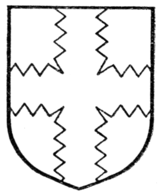When the heraldic cross was first assumed with any reason beyond geometrical convenience, there can be no doubt that it was intended to represent the Sacred Cross itself. The symbolism of the cross is older than our present system of armory, but the cross itself is more ancient than its symbolism. A cross depicted upon the long, pointed shields of those who fought for the Cross would be of that shape, with the elongated arm in base.
But the contemporary shortening of the shield, together with the introduction of charges in its angles, led naturally to the arms of the cross being so disposed that the parts of the field left visible were as nearly as possible equal. The Sacred Cross, therefore, in heraldry is now known as a "Passion Cross" (Fig. 162) (or sometimes as a "long cross"), or, if upon steps or "grieces," the number of which needs to be specified, as a "Cross Calvary" (Fig. 163). The crucifix (Fig. 164), under that description is sometimes met with as a charge.
The ordinary heraldic cross (Fig. 155) is always continued throughout the shield unless stated to be couped (Fig. 165).
Of the crosses more regularly in use may be mentioned the cross botonny (Fig. 166), the cross flory (Fig. 167), which must be distinguished from the cross fleuretté (Fig. 168); the cross moline,






